Musk
Musk is a class of aromatic substances commonly used as base notes in perfumery. They include glandular secretions from animals such as the musk deer, numerous plants emitting similar fragrances, and artificial substances with similar odors.[1][2] Musk was a name originally given to a substance with a strong odor obtained from a gland of the musk deer. The substance has been used as a popular perfume fixative since ancient times and is one of the most expensive animal products in the world. The name originates from the Late Greek μόσχος 'moskhos', from Persian 'mushk', similar to Sanskrit मुष्क muṣka ("testicle"), derived from Proto-Indo-European noun "mouse". [3][1][4] The deer gland was thought to resemble a scrotum. It is applied to various plants and animals of similar smell (e.g. muskox) and has come to encompass a wide variety of aromatic substances with similar odors, despite their often differing chemical structures and molecular shapes.
.jpg)
Natural musk was used extensively in perfumery until the late 19th century when economic and ethical motives led to the adoption of synthetic musk, which is now used almost exclusively.[5] The organic compound primarily responsible for the characteristic odor of musk is muscone.
Modern use of natural musk pods occurs in traditional Chinese medicine.
Natural sources
Musk deer
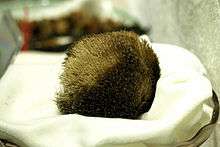
The musk deer belongs to the family Moschidae and lives in Tibet,[6] India, Pakistan, Afghanistan, China, Siberia and Mongolia. The musk pod is normally obtained by killing the male deer through traps laid in the wild. Upon drying, the reddish-brown paste inside the musk pod turns into a black granular material called "musk grain", which is then tinctured with alcohol. The aroma of the tincture gives a pleasant odor only after it is considerably diluted. No other natural substance has such a complex aroma associated with so many contradictory descriptions; however, it is usually described abstractly as animalistic, earthy and woody[5] or something akin to the odor of baby's skin.[7]
Musk has been a key constituent in many perfumes since its discovery, being held to give a perfume long-lasting power as a fixative. Today, the trade quantity of the natural musk is controlled by CITES, but illegal poaching and trading continues.[7]
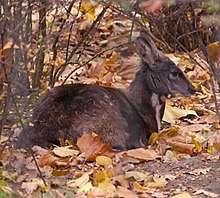 Moschus moschiferus, Siberian musk deer
Moschus moschiferus, Siberian musk deer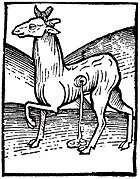 "Musk-cat", woodcut from Hortus Sanitatis, 1491
"Musk-cat", woodcut from Hortus Sanitatis, 1491
Other animals
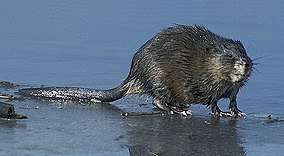
Muskrat (Ondatra zibethicus), a rodent native to North America, has been known since the 17th century to secrete a glandular substance with a musky odor.[8] A chemical means of extracting it was discovered in the 1940s, but it did not prove commercially worthwhile.[8]
Glandular substances with musk-like odors are also obtained from the musk duck (Biziura lobata) of southern Australia, the muskox, the musk shrew, the musk beetle (Aromia moschata), the African civet (Civettictis civetta), the musk turtle (Sternotherus odoratus), the American alligator of North America, lynx musk, lungurion which, in antiquity, was highly valued, and from several other animals.
In crocodiles, there are two pairs of musk glands, one pair situated at the corner of the jaw and the other pair in the cloaca.[9] Musk glands are also found in snakes.
Plants
| Wikisource has the text of the 1905 New International Encyclopedia article Musk Plant. |
Some plants such as Angelica archangelica or Abelmoschus moschatus produce musky-smelling macrocyclic lactone compounds. These compounds are widely used in perfumery as substitutes for animal musk or to alter the smell of a mixture of other musks.
The plant sources include the musk flower (Mimulus moschatus) of western North America, the muskwood (Olearia argophylla) of Australia, and the musk seeds (Abelmoschus moschatus) from India.
Artificial compounds
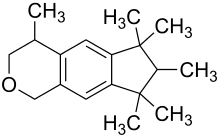
Since obtaining the deer musk requires killing the endangered animal, nearly all musk fragrance used in perfumery today is synthetic, sometimes called "white musk". They can be divided into three major classes: aromatic nitro musks, polycyclic musk compounds, and macrocyclic musk compounds.[5] The first two groups have broad uses in industry ranging from cosmetics to detergents. However, the detection of the first two chemical groups in human and environmental samples as well as their carcinogenic properties initiated a public debate on the use of these compounds and a ban or reduction of their use in many regions of the world. Macrocyclic musk compounds are expected to replace them since these compounds appear to be safer.[5]
Other uses
Musk has been used to attract wild animals, including in man-made perfume mixtures. For example, in 2018 Indian authorities used the perfume Obsession by Calvin Klein to attract and thus trap a wild tiger that had attacked and killed more than a dozen humans.[10]
Musk sticks, which are artificially flavoured with a substance that is reminiscent of musk perfume, are a popular confection in Australia.
See also
Notes
- "Merriam-Webster's Online Dictionary: musk". Merriam-Webster. Retrieved 2007-04-07.
- Chantraine, Pierre (1990). Dictionnaire étymologique de la langue grecque. Klincksieck. p. 715. ISBN 2-252-03277-4.
- Harper, Douglas. "musk". Online Etymology Dictionary.
- Chantraine, Pierre (1990). Dictionnaire étymologique de la langue grecque. Klincksieck. p. 715. ISBN 2-252-03277-4.
- Rimkus, Gerhard G. (Ed.); Cornelia Sommer (2004). "The Role of Musk and Musk Compounds in the Fragrance Industry". Synthetic Musk Fragrances in the Environment (Handbook of Environmental Chemistry). Springer. ISBN 3-540-43706-1.CS1 maint: extra text: authors list (link)
- Historical Section of the Foreign Office (Great Britain). "Tibet". Handbook (No. 70). H M Staionery Office (1920).
- Rowe, David J. (Ed.); Philip Kraft (2004). "Chapter 7. Aroma Chemicals IV: Musks". Chemistry and Technology of Flavours and Fragrances. Blackwell. ISBN 0-8493-2372-X.CS1 maint: extra text: authors list (link)
- Groom, Nigel (1997). New Perfume Handbook. Springer. pp. 219–220. ISBN 0-7514-0403-9.
- Wareham, D.C. (2005). Elsevier's Dictionary of Herpetological and Related Terminology. Elsevier Science. p. 129. ISBN 0-444-51863-0.
- "Calvin Klein's Obsession Could Be The Trick To Catching A Tiger". NPR. 14 October 2018. Retrieved 18 October 2018.
![]()
Further reading
- Borschberg, Peter, "O comércio europeu de almíscar com a Ásia no inicio da edad moderna - The European Musk Trade with Asia in the Early Modern Period", Revista Oriente, 5 (2003): 90-9.
- Borschberg, Peter, "Der asiatische Moschushandel vom frühen 15. bis zum 17. Jahrhundert", in Mirabilia Asiatica, edited by J. Alves, C. Guillot and R. Ptak. Wiesbaden and Lisbon: Harrassowitz-Fundação Oriente (2003): 65-84.